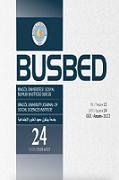THE PROBLEMATIQUE OF THE PEOPLES OF KURGAN CULTURE AND KURGAN-TYPE TOMBS EMERGED IN THE EARLY SECOND MILLENNIUM BC IN EASTERN ANATOLIA
THE PROBLEMATIQUE OF THE PEOPLES OF KURGAN CULTURE AND KURGAN-TYPE TOMBS EMERGED IN THE EARLY SECOND MILLENNIUM BC IN EASTERN ANATOLIA
Author(s): Umut Parliti, Ahmet KocaispirSubject(s): Archaeology, Museology & Heritage Studies, Regional Geography, Environmental interactions, Migration Studies
Published by: Bingöl Üniversitesi Sosyal Bilimler Enstitüsü
Keywords: Eastern Anatolia Region; 2nd Millennium BC; Kurgan; Migration; Climate;
Summary/Abstract: In the beginning of the 2nd millennium BC, the tradition of burial mounds defined as kurgan tombs emerged on the frontiers of Transcaucasia and Northwest Iran, known as the plateaus of the Eastern Anatolia Region. Contrary to the emergence of these tombs, most of the settlements in the region vanished. Political motivations may be the reason for such a change, or as claimed, people may have left the plains and started animal husbandry due to climate instabilities. Accordingly, this paper seeks to bring together these views in a theoretical framework and discuss them in light of climate, people, environment, and migration.
Journal: Bingöl Üniversitesi Sosyal Bilimler Enstitüsü Dergisi (BUSBED)
- Issue Year: 12/2022
- Issue No: 24
- Page Range: 448-461
- Page Count: 14
- Language: English

